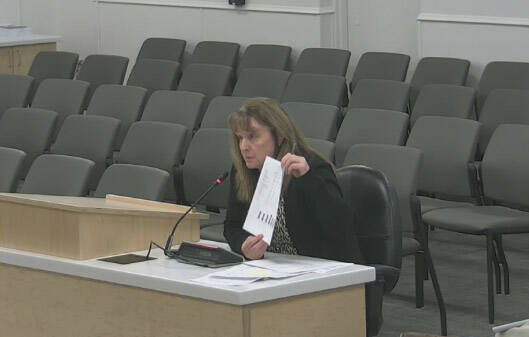The Kenai Peninsula Borough School District’s savings accounts were the subject of the latest installment in the district’s “Budget 101” series, which aims to inform the general public about how its budget process works.
KPBSD Finance Director Liz Hayes gave Monday’s presentation, which was delivered to members of the school board during a work session ahead of their regular meeting. Topics previously covered by the series include the State of Alaska’s foundation formula and in-kind services provided to the district by the Kenai Peninsula Borough.
KPBSD’s Budget 101 series comes as the school district faces a $13.1 million deficit for the upcoming fiscal year. The district dealt with a similar deficit last fiscal year, which board members decided to offset using leftover federal COVID-19 relief funds, budget cuts and money from savings — also known as fund balance.
Ultimately, KPBSD was able to bring cuts back and did not need to use any money from savings after receiving one-time bonus funding from the Alaska Legislature last session.
Fund balance — the subject of Monday’s presentation — is the monetary value of what the school district has in savings. KPBSD’s fund balance is equal to the difference between the district’s assets and its liabilities, Hayes said Monday, and includes five categories: nonspendable, restricted, committed, assigned and unassigned.
The district’s nonspendable fund balance refers to money that is either not in monetary form, such as inventory or prepaid items, or that must remain intact. Prepaid items include things like materials available for schools that are stored at the KPBSD warehouse in Soldotna until needed.
Restricted fund balance, another category, are funds attached to legal obligations. Home-school students, for example, receive financial allotments that their family can use for school materials at their discretion. Even if a student doesn’t spend their whole allotment, KPBSD still needs to have that money available for when a student decides to use it.
“If a student is enrolled in our home-school program and they do not spend all of their allocation, we have to continue to roll that forward with that student until they either graduate or leave our home-school program,” Hayes said. “Once they leave, then that money is released back into the unassigned fund balance that the board then has access to.”
KPBSD’s committed fund balance, the third category, refers to those funds formally designated by the school board for a specific purpose. Hayes said KPBSD only has one committed fund balance item, which is the district’s minimum fund balance policy. That policy outlines the minimum amount of money that the school district must keep in savings, as determined by the school board.
Then there is the district’s assigned fund balance — money for resources on which there is an intentional restraint. An example of that are school incentive purchases, which Hayes said operate like a savings account that schools can draw from, and purchases the district makes for the following school year.
Unassigned fund balance, the last category, refers to funds that are not designated for a specific purpose. The school board can spend unassigned fund balance at its discretion to meet district needs.
The school board, for example, authorized the use of about $820,000 in unassigned fund balance to help offset a $13.1 million budget deficit during the most recent budget cycle. That money ultimately was not needed, though, because state lawmakers gave Alaska school districts one-time funding during the most recent legislative session.
Together, the five categories encompass KPBSD’s fund balance.
Alaska Statute requires that school districts spend down a certain proportion of their total fund balance each fiscal year, as a way to make sure school districts aren’t saving large amounts of state money. That rule was waived during the COVID-19 pandemic, when districts had more money than usual in federal relief dollars.
School Board President Zen Kelly said during Monday’s work session that state lawmakers have suggested that school districts are sitting on savings money that could instead be used to help offset budget deficits.
“I know that this will be a topic when the Legislature reconvenes,” Kelly said. “It was said over and over in committee meetings that the Legislature had that the school districts were sitting on a bunch of money.”
Federal COVID relief dollars given to school districts, though, must be spent by the end of this year, meaning they won’t be available in fund balance for the upcoming budget cycle.
“I hope that we can communicate and dispel the myth that we’re sitting on a bunch of money and we don’t need it, because that’s just not the case,” Kelly said.
KPBSD’s “Budget 101” presentations can be streamed on the district’s BoardDocs page.
Reach reporter Ashlyn O’Hara at ashlyn.ohara@peninsulaclarion.com.

